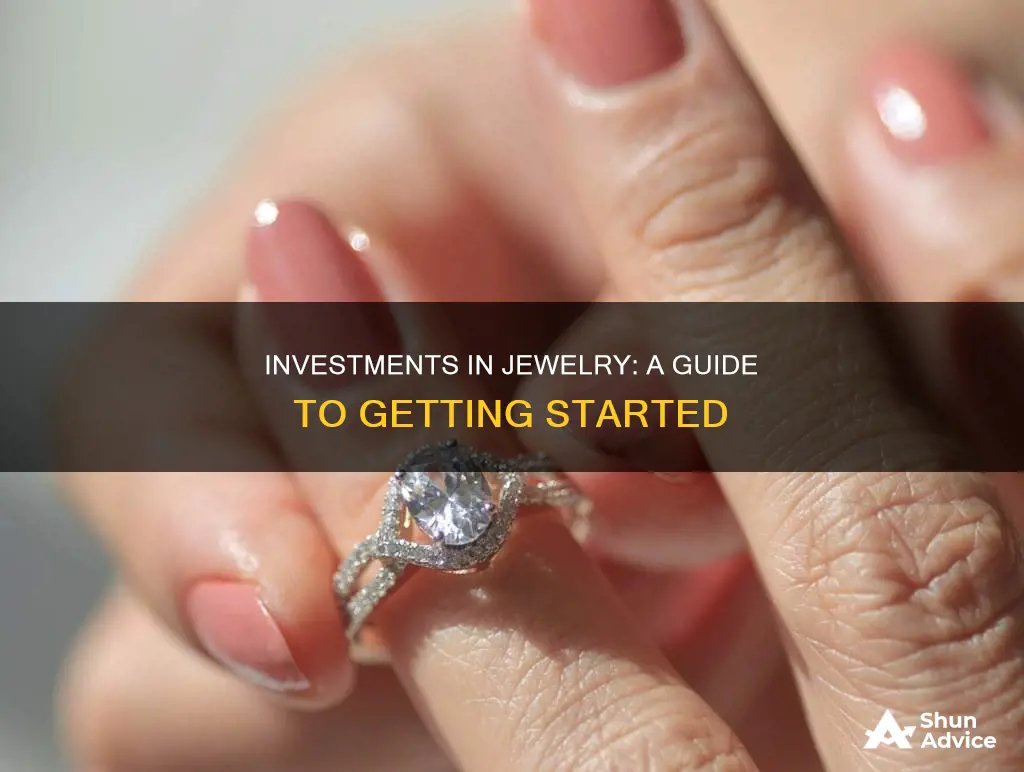
Investing in jewellery can be a fun and rewarding experience, but it's important to do your research first. Jewellery investments are similar to fine art investments, and if you're in it for the long haul, there is money to be made. The key is to know what you're doing and to treat it like any other investment.
When it comes to jewellery, the value is determined by various factors such as the purity of the metal, weight, condition, and craftsmanship. The type of jewellery and its design also play a role in its value. For example, antique jewellery needs to be at least 100 years old, and the number of karats matters – 24-karat gold is the purest but also the softest. Generally, 14-karat and 18-karat gold are recommended for everyday wear and are more stable in value.
If you're considering investing in jewellery, it's important to consult experts and do your due diligence. Know the history of the piece, including its provenance and the craftsperson. It's also crucial to buy from specialised stores and pay attention to the seller's expertise and reputation.
Some types of jewellery that tend to hold or increase in value include vintage rings, antique jewellery, pieces from famous brands, and those with precious stones such as diamonds, coloured gemstones, sapphires, rubies, and emeralds.
Additionally, consider the brand and model when investing in watches. Piaget, Cartier, and Bulgari are some of the most sought-after brands for women's watches, while Rolex, Patek Philippe, and Cartier maintain or increase their value over time.
Remember, investing in jewellery is a combination of emotion and rationality. It's important to like the piece you're investing in, but also ensure it meets the criteria for a valuable investment.
| Characteristics | Values |
|---|---|
| High demand | Gold and diamonds have been in great demand for millennia |
| Diversification | Can be used to diversify an investment portfolio |
| Value | The value of jewellery is dependent on the age, number of karats, purity of the metal, weight, condition and craftsmanship |
| Appreciation | The longer you hold on to it, the greater the profit |
| Liquidity | Jewellery is not as liquid as gold bullion and bars |
| Sentimental value | Jewellery has sentimental value and can be passed down through generations |
| Collectability | Semi-precious gemstones are highly collectible and wearable |
| Investment pieces | Diamonds, emeralds, sapphires, jadeite, garnets and rubies are more coveted |
| Research | It is important to research the seller, the piece of jewellery and the market |
| Storage | Jewellery should be stored in a bank safety deposit box or secure safe |
| Insurance | It is important to insure your jewellery |
What You'll Learn

Invest in precious metals like gold, silver, and platinum
Precious metals such as gold, silver, and platinum are popular investment options. They are often used as a hedge against economic downturns, inflation, and currency fluctuations. Here are some ways to invest in these precious metals:
Gold
Gold is a popular investment choice due to its historical role as a global currency. It is also valued for its low correlation with other asset classes, making it a good diversification tool. Here are some ways to invest in gold:
- Physical gold: You can purchase gold bullion, coins, or jewellery from dealers or pawn shops. However, this option requires storage and insurance, and there may be markups or premiums on the gold price.
- Gold mining stocks: Investing in companies that mine, refine, and trade gold can be profitable during rising gold prices. Examples include Newmont Corp., Barrick Gold Corp., and Franco-Nevada Corp.
- Gold exchange-traded funds (ETFs) and mutual funds: These provide exposure to gold's stability while offering more liquidity and diversification. Examples include SPDR Gold Shares ETF and VanEck Vectors Gold Miners ETF.
- Gold futures and options: These are derivatives that allow you to speculate on gold prices, but they are risky and require monitoring.
Silver
Silver is another precious metal that is valued for its industrial applications and role as a store of value. Here are some ways to invest in silver:
- Physical silver: You can purchase silver coins, bullion, or jewellery. This option provides psychological satisfaction, but it may be easy to overpay, and there are risks of theft and illiquidity.
- Silver futures: Silver futures allow you to speculate on silver prices without owning the physical metal. They offer high leverage but are risky and suitable for advanced traders.
- Silver ETFs: ETFs such as iShares Silver Trust and Aberdeen Standard Physical Silver Shares ETF own physical silver, providing exposure to silver prices with lower risks than owning bullion.
- Silver mining stocks: Investing in silver mining companies allows you to benefit from rising silver prices and increased production. However, individual mining companies can be risky, so extensive analysis is required.
- Silver mining ETFs: These ETFs provide diversified exposure to silver miners while reducing the risk of investing in individual companies. Examples include Global X Silver Miners ETF and iShares MSCI Global Silver Miners ETF.
Platinum
Platinum is a rare precious metal with a variety of industrial uses. It is also used in jewellery and dental work. Here are some ways to invest in platinum:
- Physical platinum: You can purchase platinum bullion, coins, or bars from trusted dealers.
- Platinum ETFs: ETFs such as ETFS Physical Platinum Shares provide exposure to platinum prices without the need to store physical platinum.
- Platinum futures: Trading platinum futures on the futures market is an advanced option and may not be suitable for beginners.
- Platinum mining stocks: Investing in platinum mining companies can be profitable during rising platinum prices. Examples include Anglo American Platinum, Impala Platinum Holdings, and Tharisa.
Remember that investing in precious metals carries risks, and it is important to do your research and consult with financial professionals before making any investment decisions.
Owner Cash Investment: Is It an Expense?
You may want to see also

Opt for rare and natural gemstones
Gemstones are a great way to diversify your investment portfolio and they can be a smart investment if you know what you're doing. They are a compact store of value, easy to store, transport, and pass on to future generations. Gemstones have proven their worth as an investment for thousands of years, surviving crises, wars, and economic upheaval without losing value.
When it comes to investing in gemstones, opt for rare and natural gemstones. These are almost always the best option for investors. The most popular and well-known gemstones are the classic "Big Three": ruby, sapphire, and emerald. These are great options for beginners as they are widely recognised and relatively easy to resell.
Rubies are the hardest mineral in the world after diamonds and much rarer. Pigeon blood-red rubies are the most sought-after, but clear red stones of 5 carats and above are absolute rarities and a great investment.
Sapphires come in many colours, but the best-known and most valuable are deep blue sapphires, especially those from the Kashmir region. Another sought-after variety is the Padparadscha sapphire, with its lotus blossom colouring.
Emeralds are the green variety of beryl. Deep green, clear specimens are the most valuable. A special cut, the emerald cut, is often used for this gemstone.
Beyond the Big Three, there are other rare and natural gemstones that are great investment options. These include:
- Alexandrite: a variety of chrysoberyl, discovered in the 19th century and named after Tsar Alexander II. It has a unique colour-changing property, shifting between red and blue depending on the light.
- Tanzanite: a deep blue stone found only in a small area in Tanzania. The export of these stones, especially larger ones, is restricted, making them very popular with investors.
- Tourmaline: found in a wide range of colours, including intense turquoise-blue, known as Paraiba tourmaline, which is highly sought-after.
- Aquamarine: the blue variety of beryl, with "Santa Maria Africana" stones from Mozambique being highly prized.
- Red Spinel: recognised as a distinct gemstone from rubies since the early 1800s, bright red and clear stones are the most in-demand.
When investing in gemstones, it is crucial to ensure their authenticity and quality. Always buy from reputable sellers and seek out independent certification from gemological laboratories. Additionally, consider the four Cs of gemstone quality: Carat (weight), Color (colour), Clarity, and Cut.
Finally, remember that investing in gemstones should bring you joy. Choose gemstones that speak to you and that you will be proud to own and display.
Ally Invest App: A User's Guide to Trading
You may want to see also

Choose classic brands and models that retain value
When investing in jewellery, it is important to consider the brand and model's ability to retain its value. Choosing classic pieces from well-known brands is a good strategy to ensure your jewellery holds its value over time. Here are some tips to help guide you in selecting jewellery that will retain its value:
Select Iconic Brands:
Opt for jewellery from renowned brands like Cartier, Tiffany & Co., and Bulgari. These brands are known for their timeless designs, quality craftsmanship, and luxury appeal, making them excellent choices for value retention.
Consider Brand Reputation and History:
The reputation and heritage of a brand play a significant role in value retention. Brands with a long history, such as Cartier (since 1845), tend to hold their value due to consumer trust and demand. Additionally, brands with a royal or celebrity association, like Cartier's Love Bracelet, often become highly sought-after and valuable.
Focus on Timeless Designs:
Invest in jewellery pieces with classic, timeless designs that transcend trends and fashion eras. For example, the Cartier Tank Watch, introduced in 1919, remains a cult classic due to its sleek, linear design. Similarly, the Tiffany & Co. Open Heart Pendant by Elsa Peretti remains relevant and stylish decades after its launch.
Look for High-Quality Materials and Craftsmanship:
Jewellery crafted with high-quality materials, such as precious metals and gemstones, tends to maintain its value. For instance, Van Cleef & Arpels is known for its commitment to exquisite craftsmanship and the use of the finest gemstones, ensuring their pieces hold their value.
Limited-Edition or Rare Pieces:
Keep an eye out for limited-edition or rare pieces, as these can become highly valuable in the resale market due to their scarcity.
By following these guidelines and choosing classic brands and models known for their quality, craftsmanship, and timeless designs, you can make informed investment decisions when purchasing jewellery that retains its value over time.
Non-Cash Investing Activities: Where Are They Reported?
You may want to see also

Collect popular period jewels
Art Deco items from the 1920s and 1930s are among the most coveted pieces of jewellery on the market. Demand has also been high for jewellery from the 1940s and 1960s. These pieces are easy to wear and resonate with modern collectors as they are vivacious, vibrant, and crafted from yellow gold. Art Deco style guidelines continue to inspire stylish and modern fine jewellers crafting elegant heirlooms. There are specific icons that will always survive the test of time, such as the Cartier 'Tank', which regularly fetches auction records.
When collecting popular period jewels, it is important to focus on vintage rings with high-quality gemstones. This will make your investment much stronger. Request an appraisal that attests to the age of the ring and carefully examine the quality of the craftsmanship. A well-crafted ring will always be far more desirable. Not all vintage rings are collector's items and investment pieces, so research is key.
Additionally, consider signed designer jewellery. While signed designer jewellery has always been the most popular jewellery of its time, what surprises most investors is that it becomes even more popular after its time. A jewellery piece crafted by one of the top jewellery designers is a fantastic investment idea. However, there are a few things to keep in mind:
- Authenticity: You will want paperwork to prove the age and make of the designer jewellery. This may not always be possible, especially with older pieces. In this case, you will want an expert to look at the stamps on the jewellery to ensure authenticity.
- Age: The vintage of the jewellery piece is one of the most compelling factors for designer jewellery. Usually, the older, the better.
- Craftsmanship: Even the best jewellery houses have pieces that are good and pieces that aren't. Before investing, you will want an expert to examine the piece to ensure the craftsmanship is up to par.
- Desirability: Consult a jewellery expert to ensure that the signed vintage designer jewellery is desirable. Not all jewellery designers are desirable.
Recording Cash Investments: A Step-by-Step Guide for Beginners
You may want to see also

Know where to sell your pieces
Knowing where to sell your jewelry pieces is key to getting a good deal. Here are some options to consider:
Online Marketplaces
Sites like eBay, Facebook Marketplace, and Etsy are great options for selling jewelry. These platforms offer a broad audience and can be used to sell various items, from expensive jewelry to unique, less-valuable goods. When selling on these sites, it's important to take clear pictures, write detailed descriptions, and set competitive prices.
Auction Houses
Auction houses, such as Sotheby's, are another option for selling your jewelry. They usually have a wide audience of bidders, which can result in a higher selling price. However, it's important to be aware of the fees involved, including buyer's premiums and seller's commissions, as these will impact your final earnings.
Local Jewelry Stores
Selling to local jewelry stores is a good option if you want to sell your jewelry in person and receive immediate payment. Research stores with good reputations near you, and understand the value of your jewelry before visiting. Don't hesitate to negotiate the price, as store owners expect it, and you may be able to get a better deal.
Pawn Shops
Pawn shops are a common choice for those who need cash right away. They will either provide a loan based on the value of your jewelry or purchase it from you outright. Before visiting a pawn shop, clean your jewelry and gather any certifications or paperwork that verifies its authenticity and value.
Consignment Shops
Consignment shops will sell your jewelry for you and take a percentage of the sale price as their fee. This fee can range from 10% to 70%, so it's important to ask about their rates beforehand. When choosing a consignment shop, check their reputation and reviews, understand their payment methods, and ask about their process for valuing and securing your items.
Online Gold Buying Companies
If you're looking to sell gold jewelry, consider using an online gold buying company like CashforGoldUSA. They offer free appraisal kits and high offers due to their competitive nature and high volume of business. They also provide free and insured shipping, and you can get your item back at no cost if you decide not to sell.
Yard Sales
For selling costume or lower-value jewelry, setting up a yard sale might be a good option. These events are perfect for selling playful dress-up accessories or everyday pieces you no longer wear. Put a mirror near your jewelry display to allow customers to try on the pieces and make on-the-spot decisions.
Direct to Consumers
Selling directly to consumers on online platforms can sometimes get you a higher price for your jewelry. This option cuts out the middleman and allows you to set competitive prices.
Specialized Services for Fine Jewelry
If you have valuable jewelry, consider using specialized services like Sotheby's auction house or Worthy. These services often have experts who can help you understand the value of your pieces and guide you through the selling process.
Research and Compare
No matter which option you choose, it's important to do your research and compare different buyers or platforms. This will help you get the best deal and ensure you're comfortable with the selling process.
QuickBooks: Recording Non-Cash Investing and Financing Activities
You may want to see also
Frequently asked questions
Jewelry is a wearable investment that has been in great demand for millennia. Gold and diamonds, in particular, have maintained their value over time, and their high demand keeps the value and profitability of your jewelry stable. Jewelry is also a good way to diversify your portfolio, and it can be passed down through generations.
Jewelry made from precious metals such as gold, silver, and platinum, as well as gems like diamonds, emeralds, rubies, and sapphires, are considered good investments. The higher the carat and the better the quality, the more valuable the piece will be. Additionally, jewelry from well-known brands like Cartier, Van Cleef & Arpels, and Rolex tends to retain or increase in value over time.
It's important to do your research and conduct due diligence before investing in any piece of jewelry. Look for hallmarks and signatures, especially from prominent houses, as these can command higher prices. Consider the age, purity, weight, condition, and craftsmanship of the piece. For gemstones, refer to the 4 Cs: Cut, Color, Clarity, and Carat Weight.
You can find investment-worthy jewelry in a variety of places, from online sites like Ruby Lane, Etsy, and eBay to local settings like antique stores, jewelry consignment shops, and auction houses. You can also attend jewelry shows and exhibitions, or even look through your own jewelry collection for signed pieces, high karatage gold, and rare gems.
Yes, it's important to be aware that investing in jewelry does come with some risks. The value of jewelry can fluctuate depending on market conditions and the demand for certain types of jewelry. It's also important to consider the liquidity of your investment, as jewelry may not be as easy to sell as other assets. Additionally, storage and insurance costs may be necessary to protect your investment.







